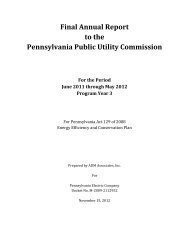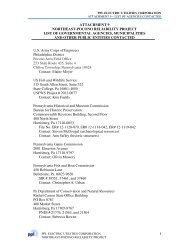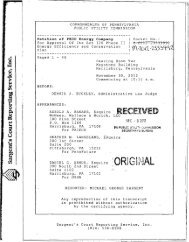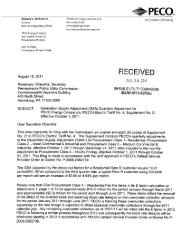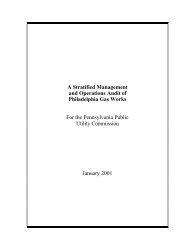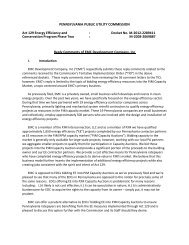2009 Report - Pennsylvania Public Utility Commission
2009 Report - Pennsylvania Public Utility Commission
2009 Report - Pennsylvania Public Utility Commission
Create successful ePaper yourself
Turn your PDF publications into a flip-book with our unique Google optimized e-Paper software.
At the time of PJM’s 2008 summer peak load, the actual reserve margin for<br />
existing capacity resources was 34,079 MW, or 26.2 percent. With an additional<br />
7,769 MW of planned new capacity, the reserve margins are expected to meet the<br />
15 percent reserve margin target through 2013. After that time, the target<br />
increases to 15.5 percent. 34 The amount of resources expected for the 2012-2013<br />
delivery year is 172,691 MW 35 , resulting in a reserve margin of 23.6 percent.<br />
The MISO net internal peak demand for the summer of <strong>2009</strong> is projected to<br />
be 102,238 MW. For the summer of 2017, the net internal demand is projected to<br />
be 114,497 MW, or an equivalent compound growth rate of 1.4 percent. The<br />
MISO market has 121,552 MW of net capacity resources for the <strong>2009</strong> summer.<br />
There is also 6,638 MW of existing capacity categorized as “uncertain” for the next<br />
8 years. The amount of proposed increase in capability from the MISO generator<br />
interconnection queue is 25,200 MW.<br />
The reserve margin for existing capacity resources is 19,314 MW in the<br />
MISO for <strong>2009</strong>, which is 18.9 percent, based on net internal demand. With an<br />
additional 4,449 MW of planned new capacity, the reserve margins are expected<br />
to meet the 14.1 percent target through 2014. The amount of proposed resources<br />
needed starts at 1,280 MW in 2015 and increases to 4,640 MW by 2017, or about<br />
18.4 percent of proposed resources in the MISO generator interconnection queue.<br />
The fuel mix of generating units in the RFC region is 15.0 percent nuclear,<br />
3.0 percent hydro and pumped storage hydro, 47.0 percent coal, 8.0 percent oil,<br />
26.0 percent gas and 1.0 percent wind and other. Although recent events provide<br />
evidence that the gas supply and coal delivery networks are near their current<br />
limits, RFC does not expect a fuel problem to affect the long term assessment.<br />
Over the next six years, there are plans within the RFC region for the<br />
addition of more than 1,600 miles of high voltage transmission lines (100 kV and<br />
above) and numerous new substations and transformers expected to enhance and<br />
strengthen the bulk transmission system. PJM’s RTEP has identified four major<br />
“backbone” projects, two of which were mentioned earlier.<br />
The Trans-Allegheny Interstate Line, scheduled for operation in 2011,<br />
consists of a new 500 kV circuit from 502 Junction to Mt. Storm to Meadow Brook<br />
to Loudon. This project will relieve anticipated overloads and voltage problems in<br />
the Washington, D.C., area, including anticipated overloads expected in 2011 on<br />
the existing 500 kV network.<br />
34 The 2008 PJM Reserve Requirement Study (October 8, 2008) recommends endorsement of a 16.2% reserve<br />
requirement for the 2012/2013 planning period.<br />
35 Existing installed capacity + expected queue generation – announced retirements.<br />
64<br />
<strong>Pennsylvania</strong> <strong>Public</strong> <strong>Utility</strong> <strong>Commission</strong>




